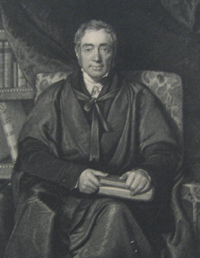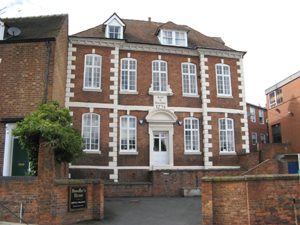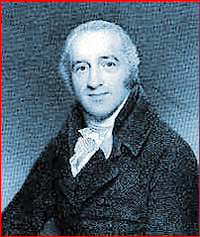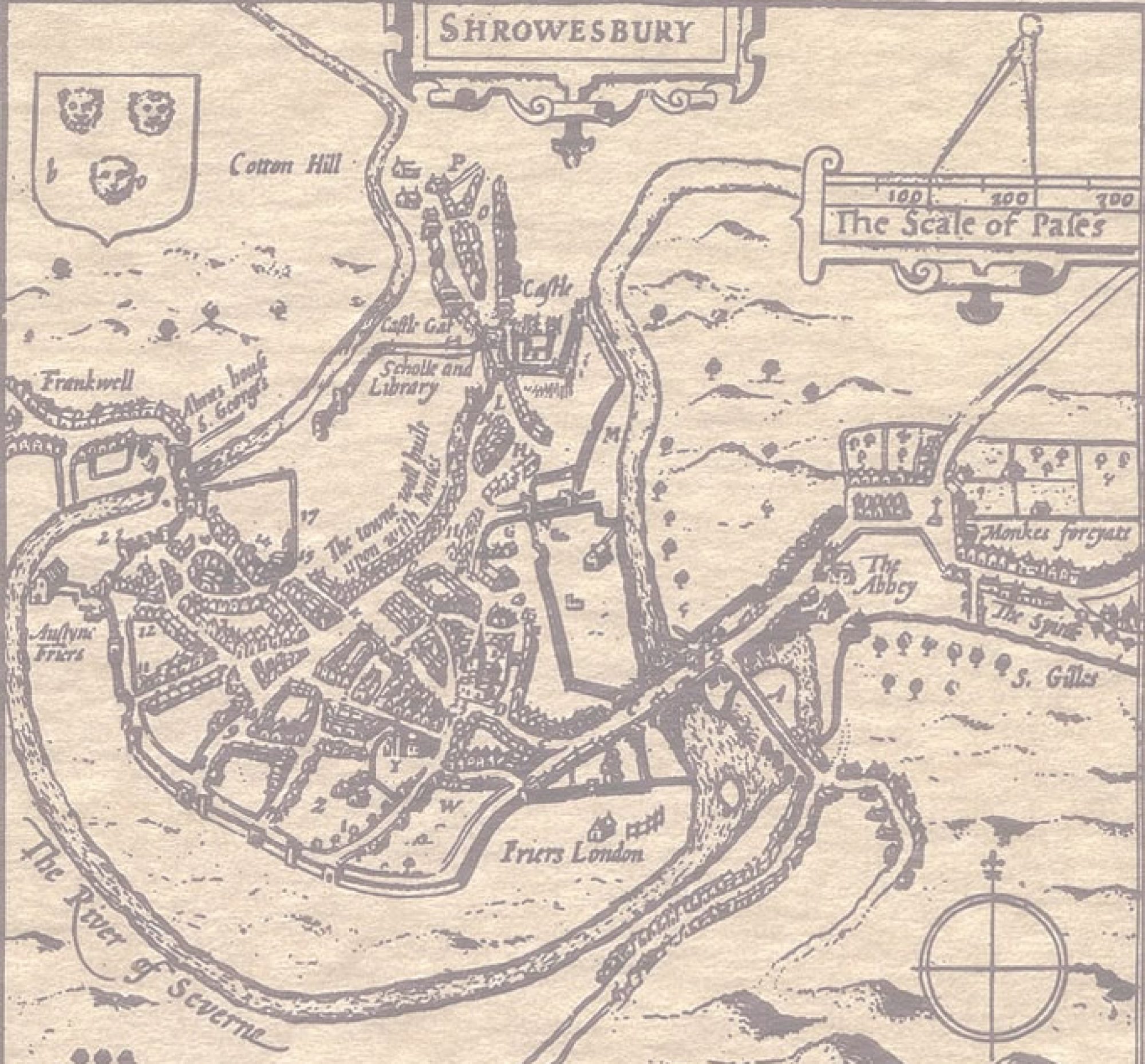
Samuel Lee (1783-1852) was the youngest of eleven children in a family from Longnor, which is just off the Shrewsbury to Church Stretton road. He received some elementary education at the Charity School in the village, ‘without distinguishing myself in any respect; for, as punishment is the only alternative generally held out, I, like others, thought it sufficient to avoid it,’ he later wrote [see footnote 1]. He was apprenticed at the age of 12 to his half-brother John, a carpenter who lived in St John’s Hill, Shrewsbury. During this time he was in the habit of reading any books that he found at his lodgings, which he sometimes took to read in his breaks at the workshops near the River Severn. These workshops were prone to flooding, and once, as one such flood was coming up, he was so absorbed in his book that ‘he was sitting with his legs under water till the men came and took him away’ [see footnote 2]. But he was frustrated that he could not understand any Latin quotations the books contained, and he determined to learn the language. First he bought a Latin grammar from a bookstall, and he proceeded to learn it by heart. After this he sold the book, and with the proceeds bought another Latin text. After repeating this process a number of times he managed to master the language, despite working full time on a wage of only 6 shillings a week.
Having finished his apprenticeship, he learned Greek in the same way and then Hebrew. As he read more he came across works in Chaldee, Syriac and Samaritan, all of which he began to master. He suffered frequently from inflammation of the eyes from reading by the light of the fire, and when he consulted Dr Thomas Dugard of Shrewsbury, the doctor was intrigued to learn that this humble carpenter was in the habit of reading at night. He was even more astonished to learn what he was reading, and how he had progressed in his language studies.
When he was 25 Samuel Lee’s life was at a crossroads. He decided to get married, but he knew that time and money would not allow him to continue with his studies afterwards. ‘I perceived that however excellent the acquisition [of languages] may have appeared to me, it was in my situation entirely useless,’ he wrote. He therefore sold his books, but shortly afterwards the young carpenter’s livelihood was jeopardised by the loss of all his tools, worth about £25, in an accidental fire in the house where he was working. Somehow Dr Dugard heard about his former patient’s plight, and knowing that he was from Longnor, discussed the situation with his friend Rev Joseph Corbett, Vicar of Longnor, and Archdeacon of Shropshire in the Diocese of Hereford.

The Archdeacon was able to use his influence to obtain the post of master of Bowdler’s School for Samuel, and he also introduced him to Jonathan Scott, who had been Persian Secretary to Warren Hastings, the first governor-general of Bengal. When he left the East, Scott had taught oriental languages at a college in London run by the East India Company, and had then retired to Shrewsbury. Scott was astonished at the progress this poor young man had made in the languages, and was delighted to lend him books and help with pronunciation. With his help, Samuel added Arabic, Persian and Hindustani (now called Urdu/Hindi) to his store of languages, and Scott noted that he was also proficient in French, German and Italian.
Archdeacon Corbett was a great supporter of both the Church Missionary Society and the Bible Society, and so it was presumably by his recommendation that the Missionary Society appointed Samuel as their teacher of Oriental Languages and also agreed to sponsor his further study [see footnote 3]. So he set off to enter Queen’s College Cambridge in early January 1814, when he was already over 30, with £5 in his pocket from the Archdeacon. His early months were filled with money worries, especially for his wife, trying to exist on £1 a week in Longnor, but the kind Dr Dugard supported her over this difficult time.

During his time as a student, Samuel was helped both practically and spiritually by Rev Charles Simeon (1759-1836), Vicar of Holy Trinity Church, Cambridge. Simeon was one of the most influential clergyman of his day, and the spiritual ‘father’ of the ‘Clapham Sect’, which numbered William Wilberforce among its members. Samuel was ‘humbled and privileged’ to be supported by such a great man, and this genuine humility was a characteristic that never left him throughout his life. Learning from Simeon and others, he became a convinced Evangelical Anglican.
As well as studying for his ordinary BA degree, Samuel threw himself into translation work for the Bible Society. His first major work was to take over the editorship of an edition of the Syriac New Testament, and he also translated or oversaw the production of biblical texts in Malay, Coptic, Persian, and Hindustani. He learned Malay during a two month Christmas vacation from Cambridge! Samuel taught these languages to outgoing missionaries, as well as Hebrew, Arabic, Sanskrit, Bengali and Ethiopian, being proficient in a total of 18 languages! A little later he helped a missionary and two Maoris to prepare the first grammar and vocabulary of the Maori language.
Graduating in 1818, he was appointed Professor of Arabic the following year, and he was ordained at this time, and for the rest of his life also had charge of various parishes, being a much-loved pastor and teacher. As well as teaching, translation and pastoral work, Samuel published a number of works of a theological nature. He also engaged in good-natured debate with opponents from both wings of the Anglican Church on subjects such as the study of the scriptures, the nature of biblical prophecy, and the Eucharist. His deep understanding of the languages of the Bible encouraged him to defend traditional interpretations of its truth. ‘I have hopes,’ he wrote of his language work early in his career, ‘that a more general diffusion of biblical knowledge will be the consequence.’ [see footnote 4] He became Professor of Hebrew at Cambridge in 1831, a post that he held till 1848.
Late in his life, after he resigned the Hebrew professorship, he took over all the parish work at Barley in Hertfordshire, as well as translating the Bible in Arabic. His daughter’s governess wrote of her experience of him during that period. ‘In visiting the sick and dying, his manner and style of conversation were gentle and encouraging, and his prayers simple and earnest,’ she recalled. ‘He was beloved and respected by all his parishioners, both Churchmen and Dissenters… As a master he was strict, but not severe…his servants universally loved and respected him.’ Samuel died on 16th December 1852 aged 69, at the rectory in Barley, where he is buried. Perhaps his most fitting epitaph is in his own words: ‘May His grace and love, shed abroad in our hearts, constrain us sweetly to sing His praise, [and] sound forth His never-failing mercies, as revealed in Christ Jesus our Lord evermore. And when we have laboured for the advancement of His glory and the good of His Church here… may we, with the voice of praise on our tongues, and the experience of heaven in our souls, be transported thither.’ [see footnote 5]
Footnotes
[1] Letter to Jonathan Scott, 26.4.1813, Shropshire Archives (SA) 6001/205. This is the most reliable source of information on Samuel Lee’s early life. See also, Thomas Hamilton and Rev John D Haigh, Oxford Dictionary of National Biography, 2001- Vol. 4 Thomas Auden, Shrewsbury, A Historical and Topographical Account of the Town, London, Methuen, Second Edition, 1923, pp. 280-282, WA Farmer, ‘Shropshire village carpenter who became University Professor of Languages’, Shropshire Magazine, December 1952, p.15 Anon, ‘Samuel Lee, the Longnor carpenter, a dullard at school, became Regius Professor of Hebrew at Cambridge’, Shropshire Magazine, November 1962, pp.22-23. For his academic career see Watton’s Cuttings, Vol. 2, p.28, SA
[2] Miss Lee, A Scholar of a Past Generation – Samuel Lee DD, London, Seeley and Co, 1896, p.8
[3] Letters of Samuel Lee to Jonathan Scott, 28.12.1813, SA 6001/205
[4] Letter of Samuel Lee to Mrs E Hill of Hawkstone, 1819, SA 549/113
[5] Miss Lee, A Scholar of a Past Generation – Samuel Lee DD, London, Seeley and Co, 1896, p.227, quotation is slightly altered to help understanding for the modern reader
